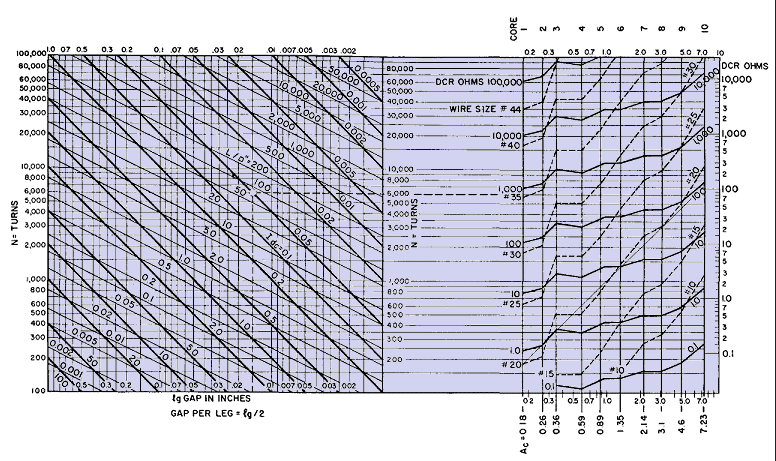| Electronic Transformers and Circuits is a free introductory textbook on transformers and related circuits. See the editorial for more information.... |

|

Home  Rectifier Transformers and Reactors Rectifier Transformers and Reactors  Linear Reactor Chart Linear Reactor Chart |
||||






|
||||
Linear Reactor Chart
Dotted lines in quadrant I are plots of turns vs. core area for a given wire size and for low-voltage coils, where insulation and margins are governed largely by mechanical considerations. Core numbers in Fig. 71 have the same dimensions and weight as in Table VIII. If the cores increased in each dimension by exactly the same amount, the lines in quadrant I would be straight. In an actual line of cores, several factors cause the lines to be wavy: (a) Ratios of core window height to window width and core area deviate from constancy. (b) Coil margins increase stepwise. (c) Insulation thickness increases stepwise. A-c flux density in the core may be calculated by equation 36, and Bdc by equation 35. If Bm materially exceeds 15,000 gauss, saturation is reached, and the reactor may become non-linear or noisy. Instructions for Using Fig. 71. 1. Estimate core to be used. 2. Divide required inductance by area (Ac) of estimated core to obtain a value of L/sq in. 3. In second quadrant, locate intersection of L/sq in. and rated Idc. 4. On this intersection, read total gap length (lg) and number of turns (N). Gap per leg = lg/2. 5. Project intersection horizontally into first quadrant to intersect vertical line which corresponds to estimated core. This second intersection gives d-c resistance and wire size.
Example. Required: 15 henrys at Idc = 50 ma. Estimate core No. 1. L/sq in. = 84.3, lg = 0.015 in., N = 6,000, DCR = 800 ohms. Wire size = No. 36. (Example shown starting with dotted circle.)
A similar chart may be drawn for silicon-steel laminations, but to maintain linearity lower values of flux density should be used.
|
||||
Home  Rectifier Transformers and Reactors Rectifier Transformers and Reactors  Linear Reactor Chart Linear Reactor Chart |
||||
Last Update: 2011-01-24


